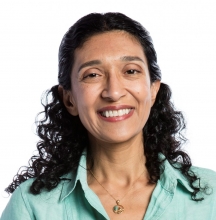BME Lecture Series: Azita Emami, Caltech

Andrew and Peggy Cherng Professor of Electrical Engineering and Medical Engineering
Heritage Medical Research Institute Investigator
Abstract: Microscale implantable and wearable devices will transform the field of medicine in the near future. This talk will focus on design and implementation of miniaturized minimally invasive devices for continuous monitoring and closed-loop therapeutic systems. In particular, an implantable wireless sensor that can continuously monitor glucose level (eliminating the need for finger-pricking) will be discussed. We will show that by bringing together novel integrated-circuit techniques, nanotechnology and interface engineering, small size, high sensitivity and longer lifetime can be achieved.
In the second part of this talk, an MRI-inspired approach for precise localization and tracking of smart pills and sensors inside the body will be presented. The prototype devices called ATOMS (Addressable Transmitters Operated as Magnetic Spins) are designed to behave similarly to real atoms in the body. They radiate at different frequencies depending on their location without the need for the strong magnetic field required in MRI. Our research efforts on efficient neural interfaces will be briefly discussed at the end of this talk.
Bio: Emami is the Andrew and Peggy Cherng Professor of Electrical Engineering and Medical Engineering at Caltech, and a Heritage Medical Research Institute investigator. She also serves as the executive officer (department head) for electrical engineering. She received her M.S. and Ph.D. degrees in electrical engineering from Stanford University in 1999 and 2004 respectively, and her B.S. degree from Sharif University of Technology in 1996. From 2004 to 2006 she was with IBM T. J. Watson Research Center before joining Caltech in 2007. Her current research interests include integrated circuits and systems, integrated photonics, wearable and implantable devices for neural recording, neural stimulation, sensing and drug delivery. She is currently the associate editor for the IEEE Journal of Solid State Circuits (JSSC) and an IEEE SSCS distinguished lecturer.
Share
Upcoming Events
-
CEE Ph.D. Defense Announcement: Release, Transport and Fate of Per- and Polyfluoroalkyl Substances (PFAS) in Urban Watersheds
-
MSE 298 Seminar: Mechano-Electrochemical Phenomena at Ceramic Electrolyte Interfaces
-
MSE 298 Seminar: Innovation In Materials Science - An Industrial R&D Perspective
-
MSE 298 Seminar: Understanding the Impact of Grain Boundary Inclination on Grain Growth Using Modeling and Simulation and Experiments
-
EECS Seminar: Mixed Conductors for Bioelectronics
